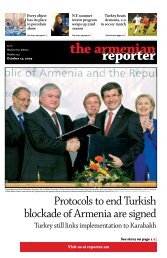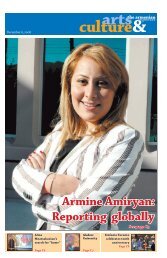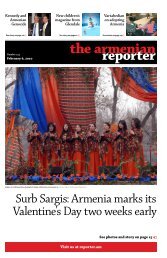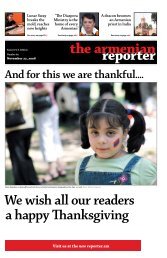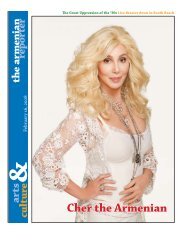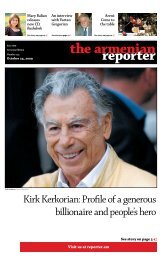18 The <strong>Armenia</strong>n Reporter | November 8, 2008<strong>Armenia</strong>armeniaat workProfessor Yeritsyan’s immeasurable wealthby Armen HakobyanWriting about well-known people isboth easy <strong>and</strong> difficult. It’s easy becausemost times an introductionis not necessary. Difficult becausewith their status comes responsibility,especially when what they dois unique <strong>and</strong> remarkable.The hero of our story, Martin Yeritsyan,professor of the quartet departmentat Komitas Conservatoryof Music in Yerevan is someonewho is creating miracles in his profession.Besides being a musician<strong>and</strong> a pedagogue, he also makesviolins; the son <strong>and</strong> successor of arenowned master of violin makingor luthier, Shahen Yeritsyan. He isa person with equally interestingperceptions of the world with anaristocratic air about him.tttA heavy metal door opens <strong>and</strong> itfeels as though you are entering animaginary world. In reality it is asmall room in the basement of theAram Khachatrian Museum in Yerevan.The chairs <strong>and</strong> music st<strong>and</strong>s,the pictures on the walls, the photographs,the posters <strong>and</strong> musicalinstruments for a string quartet remindyou that it is not an ordinaryroom.After getting to know the ownerof the room <strong>and</strong> feeling the warmthof his kindness, it feels as if thereare no walls <strong>and</strong> you are in a vast<strong>and</strong> breathtakingly beautiful gardenof flowers.I bring the instrument to themaster. He sits in front of his worktable, where tools necessary for aluthier have been placed with care.For a second I feel like I am committinga crime for interruptingthe work of a renowned master forsuch a minor repair. I tell him howI feel.“You are wrong, my dear,” respondsMartin Yeritsyan.He picks up the violin <strong>and</strong> after afew seconds says, “It is the productof the Moscow factory.” Then heexamines the “stamp” more closely<strong>and</strong> smiles as if he has met an oldacquaintance. “I have worked onthis violin at least once before, nineor ten years ago,” he says. Of course,Martin Yeritsyan, just like all masterviolin makers has his own signature,through which hundredsof his instruments are identifiable.But how did he manage to recall exactlywhen he worked on this particularfactory production, whichappears to have no outst<strong>and</strong>ingdetails? “Do you see this string?Only I had these stings in <strong>Armenia</strong><strong>and</strong> I used them about 9-10 yearsago,” smiles Martin Yeritsyan as hestretches <strong>and</strong> fixes the strings. Fora second, he truly does look like akind magician from a fairy tale; justas my daughter had described himafter seeing him for the first time.I thank the master <strong>and</strong> ask himhow much I have to pay. He smilesagain, “Nothing. Tell the child topractice well…”Call of the forefatherI go through Meroujhan Simonian’srecently published YeritsyanLuthiers which, meticulously analysesthe individualized musicalinstruments prepared by Shahen<strong>and</strong> Martin Yeritsyan <strong>and</strong> Hakob<strong>and</strong> Samvel Yeritsyan. He writesabout the lives of these <strong>Armenia</strong>nmen. Nevertheless, at the startof my conversation with MartinYeritsyan I ask the master to talkabout his origins <strong>and</strong> his renownedfather Shahen Yeritsyan. I learn atruly interesting, touching <strong>and</strong>very <strong>Armenia</strong>n story; the story ofShahen Yeritsyan who was born inTrabizond, witnessed the horrorsof the Genocide at an early age,miraculously escaped the Turkishsword with his brother Masis (heMartin Yeritsyan in his studio. Photos: Armen Hakobyan for the <strong>Armenia</strong>n Reporter.later became a victim of Stalin’s repressions)<strong>and</strong> his maternal cousinHakob. For some time he foundshelter with Kurdish nomads as aherdsman. The story of the escapeof the Yeritsyan brothers continuesin Greece, at the boys’ orphanageof Salonika, which eventhough was called American, wasactually sponsored by wealthy <strong>Armenia</strong>ns.This is where young ShahenYeritsyan became acquaintedwith the violin <strong>and</strong> the nuancesof creating this amazing instrument.This is where he learned thesecrets of the Italian masters ofviolin making.“My father moved to <strong>Armenia</strong> in1925 with his maternal gr<strong>and</strong>mother,Mariam. Since he was already amaster, he established his studio inYerevan. He made m<strong>and</strong>olins, guitars,violas, violins, cellos,” Martinrecalls.Numerous generations of musicians<strong>and</strong> professional performershave grown up <strong>and</strong> mesmerizedaudiences in concert halls withMartin Yeritsyanholding theremnants of aviolin destroyedduring the 1988earthquake.their performances on uniqueinstruments prepared by MasterShahen.During those years they beganto bring violins to <strong>Armenia</strong> madeby renowned masters of the past.Gradually a collection of instrumentsmade by Italian <strong>and</strong> Frenchmasters from the 17th <strong>and</strong> 18thcenturies were brought to <strong>Armenia</strong>.The instruments came fromdifferent cities, including Moscow<strong>and</strong> Saint-Petersburg. SahakKarapetian, president of the Soviet<strong>Armenia</strong> Council of Ministers,Karp Dombaev, ConstantinSarajev, Vazgen I, the Catholicosof All <strong>Armenia</strong>ns <strong>and</strong> many otherdevotees contributed to this collection.Due to their efforts, <strong>Armenia</strong>currently has a collection ofabout 20-22 valuable <strong>and</strong> uniqueItalian string instruments, madeby Guarneri, Guadanini, Galliano,Belgontsi <strong>and</strong> other famous masters.There are also instrumentsmade by a famous <strong>Armenia</strong>n, ShahenYeritsyan: two violins made in1933, one viola made in 1935 <strong>and</strong> acello made in 1938.With typical modesty, MartinYeritsyan doesn’t mention that heis the guardian <strong>and</strong> restorer of thatcollection.Faithful to the call ofthe master“ I was born in January 31, 1932, inYerevan in our house on MaximGorki Street which my father constructedtogether with my motherSiranoush. From a young age I wasalways in my father’s studio. WhenI was a student, my father alwaysinsisted <strong>and</strong> advised that I shouldfirst of all become a good violinist<strong>and</strong> only after that should I studymaking violins. Following his advice,I graduated from YerevanState Conservatory after which, Istudied toward my PhD. After preparinga concert program, whichtook me three years, I was immediatelyadmitted to <strong>Armenia</strong>’s philharmonicquartet as second violinist,”recounts the master.Living inside the Iron Curtainduring the Soviet era made it almostimpossible to achieve internationalrecognition, let alone goon concert tours to foreign countries.However, <strong>Armenia</strong>’s philharmonicquartet, composed of firstviolin Levon Mamikonian, secondviolin Martin Yeritsyan, viola YuriManukian <strong>and</strong> cello Felix Simonian,was allowed to participate in the internationalQueen Elizabeth competitionin Belgium in 1969 winninghigh acclaim <strong>and</strong> a special diploma.“It was an unprecedented thing inthe Soviet Union that a group oreven a solo performer from <strong>Armenia</strong>received permission to travelabroad. Seldom did they manage toget permission to participate in aninternational competition abroad,”notes my interlocutor.“After thatconcert the geography of out concerttour, of course, broadened. Wepreformed in Italy, France, otherEuropean countries <strong>and</strong> then in thedifferent cities of the USSR, evenSiberia.”Those were the years of stardomfor the quartet. From 1973 to 1975the quartet performed 26 pieceswritten for quartet by <strong>Armenia</strong>ncomposers; experts consider this aunique undertaking. Today, the 46string quartet recordings by thesetalented musicians are kept in therecord library of Radio <strong>Armenia</strong>.1975 was a significant year inMartin Yeritsyan’s life. It was thatyear that he chose to leave hisprofessional career as a violinistto become a teacher. More importantlyit was the year that his guidein life, great teacher, <strong>and</strong> fatherMaster Shahen Yeritsyan passedaway. Martin, who masters the artof delicate engraving, prepared amemorial as a symbol of his love<strong>and</strong> gratitude towards his father,reproducing a lacework stone-crosscreated by medieval master craftsmen.He erected larger memorialsby continuing his father’s missionof making violins that are works ofart with more punctiliousness <strong>and</strong>fervor. He simultaneously continuedhis teaching.Traveling the roadprepared by hisgr<strong>and</strong>father <strong>and</strong> fatherI ask Professor Yeritisyan to takeme on a tour <strong>and</strong> recount the storiesbehind the photos <strong>and</strong> posterson the walls. Every single one ofthem has a unique history just likethe tools of the master, the majorityof which he inherited fromhis father. He brought those tools,which bear the stamps of famousFrench, Swiss <strong>and</strong> American companiesfrom Greece. According tothe master craftsman, “They canprobably be used for another 200years, because all of them havebeen made from high quality materials.”He can talk endlessly about theintricacies of making a violin, beginningwith the quality <strong>and</strong> drynessof the pine wood <strong>and</strong> thecurvature of the upper body <strong>and</strong>ending with the significance of thelacquer. But I am more interested
The <strong>Armenia</strong>n Reporter | November 8, 2008 19<strong>Armenia</strong>Martin Yeritsyan, st<strong>and</strong>ing center, participates in a master class led by VahagnNikoghosyan, seated 2nd from right, in the U.S. – at Oberlin. Yeritsyan archive.Pochette, 2006.Martin Yeritsyan holding a sound board of a violin.Three generations of Yeritsyans, Martin (l.) Karen, Shahen. Photo: Yeritsyan archive.Professor Yeritsyan’s immeasurable wealthto know if there are people who willcontinue the work of the master.“Usually this is an art or craft whichis h<strong>and</strong>ed down. My father was theone who established it in <strong>Armenia</strong>.To date his instruments are highlyvalued, as he created amazing instrumentswith an Italian timbre.Currently there are talented <strong>and</strong>superior youngsters at the conservatorywho play on violins, violas<strong>and</strong> cellos made by my father <strong>and</strong> I.Many have become laureates.“And, as I already said, since this isusually h<strong>and</strong>ed down, currently mysons continue the work. My olderson Tigran lives in Spain <strong>and</strong> plays,”Martin explains. Tigran is not onlya musician but he also renovates<strong>and</strong> makes instruments there.“My younger son Karen is herewith me <strong>and</strong> we work together.Karen is also both a musician <strong>and</strong>makes instruments. In 1990 hereceived a diploma as a talentedmaster at the <strong>International</strong> TchaikovskyCompetition. As a violinisthe played together with ArtashesMkrtchian, Martin Yavrian <strong>and</strong>Barouyr Shahaziayan in the AramKhachatrian String Quartet <strong>and</strong>there was something symbolic inthat. However, since that quartetno longer exists, he spends moretime on making new instruments. Iam hopeful <strong>and</strong> sure that my gr<strong>and</strong>children[the master has 7 gr<strong>and</strong>children<strong>and</strong> 3 great gr<strong>and</strong>children]will also be able to continue thisfamily craft established by theirgreat gr<strong>and</strong>father,” says the muchhonored master with a luminous<strong>and</strong> kind expression while showingme their photographs.One of the most honest<strong>and</strong> difficult worksSo far Master Martin Yeritsyan hasprepared more than 500 violins,about 300 violas <strong>and</strong> 30 cellos, notcounting the more than 20 kanons,15 kemanis, 7 bass kemanis, 2 violada gambas, 2 pochettes <strong>and</strong> 2 violapomposa. By the way the making ofviola pomposas has an interestingstory. “English viola player SimonRowl<strong>and</strong>-Johns asked me to make afive string violas for him with whichhe could play Bach’s suites. Bachwrote suites for the cello <strong>and</strong> in orderto play them on the viola, he requestedsuch an instrument, namingit ‘viola pomposa.’ Within a year,Rowl<strong>and</strong>-Johns recorded all thosesuites in Engl<strong>and</strong> using the instrumentmade by me. He sent me twoof his CDs. What I am trying to sayis that you have to be devoted to theart of creating musical instruments.You have to devote yourself to thework in order to create somethingvaluable <strong>and</strong> worthy of admiration,”says my renowned interlocutor.He then turns to the cellos: “Iam proud that I am now workingon my 31st cello. When I finishedthe 29th, our talented cellist VahramSarajian played Babajanian’sconcerto on it during the openingceremony of the Aram KhachatrianCellists Competition <strong>and</strong> the entireaudience was thrilled <strong>and</strong> amazed.When it was announced that Saranjianwas to play on Martin Yeritsyan’s29th cello, the entire hallalso applauded for me, since theinstrument sounded thrilling <strong>and</strong>I was proud of that.” Another oneof Martin Yeritsyan’s cellos wonan award during the Stradivarius<strong>International</strong> Competition in 1980(Italy). This was followed by manyother awards <strong>and</strong> diplomas at differentprofessional reviews. Themaster has given <strong>Armenia</strong>n namesto the majority of his instruments:Masis, Gohar, Rouzanna…I ask the master what it means tohim when he makes a violin. “Makinga violin is one of the most honest<strong>and</strong> difficult things to do. It is avery difficult job, of course, becauseit dem<strong>and</strong>s great energy <strong>and</strong> devotion;great devotion to finishingthe work <strong>and</strong> creating the best instrument.To me it is God’s greatestgift which I have inherited frommy father. I have learned the craft,it can be called art now, with thehelp of which my works are alreadyfamous throughout the world,” hesays.It seems as if inanimate objectscome to life at the touch <strong>and</strong> skillin his fingers. Is it magic? No. Thereis no magic here. There is simplya skill which has reached perfection.Striving for perfection canbe viewed as a unique miracle; themiracle of loving one’s work <strong>and</strong>devoting oneself completely to it.Fragments from thedisaster of 1988My experience as a journalist tellsme that a remnant of a violin thatI see hanging from the wall has astory. When I ask about it, MasterYeritsyan tells me that during thedevastating earthquake of 1988 theviolin, which had been made for astudent had been buried under theruins <strong>and</strong> severely damaged. Thelittle owner of the violin had fortunatelysurvived. His family hadbrought the damaged violin to themaster, in order for him to renovateit. “It was a damaged instrument.I renovated it. I kept the upperbody of the violin as a souvenir,”says that master <strong>and</strong> falls silent.Breaking the silence I ask the <strong>Armenia</strong>nviolin magician how it feelswhen people bring instrumentsto him which he has made: “I feelhappy especially when,if I had forgottenabout the instrument, thedate on the label inside will remindme of when I made it. I rememberwho ordered it. It sometimesturns out that the instrument hadbeen ordered by one person <strong>and</strong> intime has gone from one h<strong>and</strong> to another.When I see the instrumentsagain it feels as though they havereturned home. Every one of myinstruments are dear to me. Allottingthat much time <strong>and</strong> h<strong>and</strong>lingthe instrument continuously whileworking on it creates a bond.”I ask him if he has ever tried tomake his own unique violin by makingsome innovative changes.“Ofcourse I have. Probably I was influencedby Picasso when I decided tocreate a completely atypical violin.And imagine I was able to createsuch a distorted instrument. Oneof them was some 30-40 years ago.When Rogiero Ricci was in Yerevanfor a concert, I asked Ohan Durianto show him the violin <strong>and</strong> tryto play on it. After seeing the instrumenthe started to play on it<strong>and</strong> noted that the tone was verygood. The instrument was soldmany years ago. I once received anorder for an electric violin, withan original shape. However, thosewere mainly experimental <strong>and</strong> donot have a future. It is unnecessaryfor a professional master to w<strong>and</strong>eraway from the classical.”I do not need a lot ofmoneyOther than earning money, whatelse can a job offer? “It gives onea passion to live. I know that tomorrowI have to get up <strong>and</strong> finishone instrument <strong>and</strong> then create another,which will enter the pages ofhistory,” notes the master.I ask the master luthier whatit means for himto live <strong>and</strong> workin <strong>Armenia</strong>.“You know, my fathercould have gone to Europe, for example,to France. He could havegone to America <strong>and</strong> become a renownedmaster there <strong>and</strong> a verywealthy person, but he preferredto come to <strong>Armenia</strong> <strong>and</strong> live inhis country. Even now I havemany friends who invite me to goabroad, to America, stating that Ican become a very, very wealthyman in a year. However, I do notneed that much money. For me itis more important to make instrumentsfor young <strong>Armenia</strong>ns whichwill always be remembered, here inA gift to MasterYeritsyan froman <strong>Armenia</strong>nartist.the house constructed by my father<strong>and</strong> where I was born. Even thoughI have received many orders fromabroad, I prefer making inexpensiveinstruments for <strong>Armenia</strong>nchildren, the <strong>Armenia</strong>n youth, forthem to play on a good instrument<strong>and</strong> play here,” he tells me frankly.“Seeing them play on instrumentsmade by me is the greatest happiness<strong>and</strong> pleasure; the greatest rewardfor my efforts.”After a moment of reflection, hecontinues, “Do you know what livingin <strong>Armenia</strong> means? The air <strong>and</strong>water that <strong>Armenia</strong> has… I havebeen in many countries, but thosethings are not as they are in <strong>Armenia</strong>.Wealth is that which you havebeen given. Thank God I am stillvery rich. I am rich when a studentplays on one of my instruments<strong>and</strong> afterwards, seeing me, greetsme with a smile. I feel that I am doinga good thing for my nation, forthe <strong>Armenia</strong>n child, for talentedviolinists <strong>and</strong> for people in general.”ttt…I am walking along BaghramianAvenue. It is a typical autumn dayin Yerevan. Trees with their yellow<strong>and</strong> red leaves are poking theirheads out between the buildings. Iwalk <strong>and</strong> feel proud for that I amliving in the same country as MartinYeritsyan, that I have such acompatriot. I feel as if the worldhas somehow exp<strong>and</strong>ed after meetingwith the <strong>Armenia</strong>n magician ofthe violin; kinder <strong>and</strong> purer. f
- Page 1 and 2: ProfessorYeritsyan’simmeasurablew
- Page 3 and 4: Number 87November 8, 2008the armeni
- Page 5 and 6: The Armenian Reporter | November 8,
- Page 7 and 8: The Armenian Reporter | November 8,
- Page 9 and 10: The Armenian Reporter | November 8,
- Page 11 and 12: The Armenian Reporter | November 8,
- Page 13 and 14: The Armenian Reporter | November 8,
- Page 15 and 16: The Armenian Reporter | November 8,
- Page 17 and 18: The Armenian Reporter | November 8,
- Page 19: The Armenian Reporter | November 8,
- Page 23 and 24: The Armenian Reporter | November 8,
- Page 25 and 26: The Armenian Reporter | November 8,
- Page 27 and 28: The Armenian Reporter | November 8,



